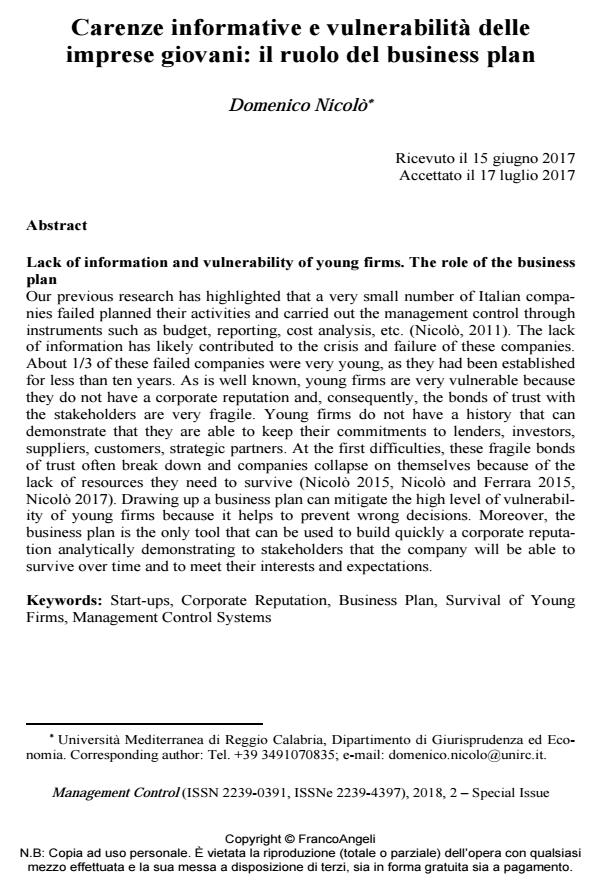Carenze informative e vulnerabilità delle imprese giovani: il ruolo del business plan
Titolo Rivista MANAGEMENT CONTROL
Autori/Curatori Domenico Nicolò
Anno di pubblicazione 2018 Fascicolo 2018/2 Suppl.
Lingua Italiano Numero pagine 16 P. 37-52 Dimensione file 219 KB
DOI 10.3280/MACO2018-SU2003
Il DOI è il codice a barre della proprietà intellettuale: per saperne di più
clicca qui
Qui sotto puoi vedere in anteprima la prima pagina di questo articolo.
Se questo articolo ti interessa, lo puoi acquistare (e scaricare in formato pdf) seguendo le facili indicazioni per acquistare il download credit. Acquista Download Credits per scaricare questo Articolo in formato PDF

FrancoAngeli è membro della Publishers International Linking Association, Inc (PILA)associazione indipendente e non profit per facilitare (attraverso i servizi tecnologici implementati da CrossRef.org) l’accesso degli studiosi ai contenuti digitali nelle pubblicazioni professionali e scientifiche
Our previous research has highlighted that a very small number of Italian compa-nies failed planned their activities and carried out the management control through instruments such as budget, reporting, cost analysis, etc. (Nicolò, 2011). The lack of information has likely contributed to the crisis and failure of these companies. About 1/3 of these failed companies were very young, as they had been established for less than ten years. As is well known, young firms are very vulnerable because they do not have a corporate reputation and, consequently, the bonds of trust with the stakeholders are very fragile. Young firms do not have a history that can demonstrate that they are able to keep their commitments to lenders, investors, suppliers, customers, strategic partners. At the first difficulties, these fragile bonds of trust often break down and companies collapse on themselves because of the lack of resources they need to survive (Nicolò 2015, Nicolò and Ferrara 2015, Nicolò 2017). Drawing up a business plan can mitigate the high level of vulnerability of young firms because it helps to prevent wrong decisions. Moreover, the business plan is the only tool that can be used to build quickly a corporate reputation analytically demonstrating to stakeholders that the company will be able to survive over time and to meet their interests and expectations.
Parole chiave:Start-ups, Corporate Reputation, Business Plan, Survival of Young Firms, Management Control Systems
- Management accounting systems in venture capital-backed start-up companies Simone Aresu, Luigi Rombi, Andrea Cardia, in MANAGEMENT CONTROL 3/2019 pp.35
DOI: 10.3280/MACO2019-003003 - Managing uncertainty in the start-up environment. Is a business plan an incentive or a limitation? Giovanna Mariani, Davide Morelli, Leonardo Bartoloni, in MANAGEMENT CONTROL 1/2019 pp.73
DOI: 10.3280/MACO2019-001004
Domenico Nicolò, Carenze informative e vulnerabilità delle imprese giovani: il ruolo del business plan in "MANAGEMENT CONTROL" 2 Suppl./2018, pp 37-52, DOI: 10.3280/MACO2018-SU2003